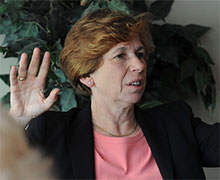The career ladder in teaching needs a few more rungs - creating more opportunities for teachers to step up into leadership roles and strengthen the profession.

"We can't just be calling out what's wrong, we have to be offering solutions on how to do it better," said American Federation of Teachers President Randi Weingarten. "Education reform has to come from the ground up, not from those outside the profession."
Creating new leadership pathways will help improve job satisfaction and retention of the best teachers, Weingarten told about 200 central New York educators who recently attended Syracuse University's fourth annual Teacher Leadership Conference.
"Some bloggers are calling it Education Spring," Weingarten said. "I see it as grassroots activism where teacher leaders are taking meaningful roles to build things up - not just shake things up."
This year's conference focused on teachers' roles in providing leadership as schools continue to implement new reforms, especially the Common Core Learning Standards, teacher and principal annual performance reviews and new state assessments.
Weingarten noted a recent MetLife survey found half of the teachers surveyed expressed interest in teaching part-time in order to have a teacher leadership role. "Most do not want to become principals," Weingarten said. "They really like being rooted in teaching and want to expand their role."
Teacher leadership can take many forms, she said, from serving on a policy committee to writing curriculum to mentoring a colleague.
"Peer leadership is having a renaissance," she said, noting informal peer assistance was crucial for her when she entered teaching. "I wouldn't be standing here in front of you today, if it hadn't been for the informal peer support I received from a colleague. It was survival for me."
Weingarten said other types of teacher leadership include taking on the role of yearbook adviser or debate coach, where you can help quiet students blossom into confident leaders or help disengaged students become involved. Others can assume leadership roles through union involvement.
She cited numerous examples where the union has sparked meaningful professional development and educational reform, including the AFT-funded lnnovation Initiative project here in New York where several locals have created a model teacher evaluation system that focuses on professional growth.
She put in a plug for AFT's Share My Lesson program, where teachers take a valuable leadership role by posting educational resources and sharing best-practice lesson plans (See page 29).
"Developing teacher leadership is not a wish, not a nice idea, not optional," Weingarten said. "Teachers taking the lead is nothing less than essential."
NYSUT Vice President Kathleen Donahue introduced Weingarten at the conference, noting the AFT leader's emphasis on "solution-driven unionism." Weingarten has called for a moratorium on using results of the new Common Core assessments to make high-stakes decisions for students and teachers. The U.S. Department of Education recently updated its policy to allow districts more time to implement Common Core. (See page 21.)
After Weingarten's keynote address, participants cycled through a series of breakout sessions where teachers, administrators and higher education faculty showcased examples of teacher leadership in action.
Breakouts included "The Role of Teacher Centers in Professional Development," "Teacher Leadership in the APPR Process," "A SUNY Cortland Oneonta Writing Project," "Empowering Teachers through Lesson Study" and "How to Get Teachers Involved in National Board Certification."
The conference also featured about a dozen poster session projects during which area teachers shared positive experiences with a variety of teacher-led initiatives.
Liverpool middle school teachers Bridget Colabello and Kristi Carroll shared information about an interdisciplinary World War II student project, while Syracuse teachers explained how their Peer Assistance and Review program helps improve teaching and learning.
Melissa Pietricola of Fayetteville-Manlius shared the results of a survey that assessed teacher satisfaction with professional development. After a small group of teacher leaders surveyed colleagues and presented the findings to the Board of Education, the district agreed to add four additional half-days of professional development specifically requested by teachers.
"Rather than bringing in outside speakers to provide professional development, teachers said they would prefer 'in-house brain power' and time to work together and collaborate, Pietricola said. "Not only were teachers asked for input, they actually listened. We got real results."
Teachers interested in lead roles beyond the classroom
Few teachers want to become principals, but half are interested in hybrid, part-time classroom teaching combined with other roles in their school or district, according to the MetLife Survey of the American Teacher released in February.
Half, or 51 percent of teachers surveyed in December 2012, said they were at least somewhat interested in teaching in the classroom part-time combined with other roles or responsibilities in their school or district, including 23 percent who are extremely or very interested in this option. In contrast, fewer than 2 in 10, or 16 percent of teachers said they were at least somewhat interested in becoming a principal, including only 6 percent who are extremely or very interested in this option. In fact, most teachers - 69 percent - said they were not at all interested in becoming a principal.
About half of those surveyed reported having a leadership role in their school, such as department chair, instructional resource, teacher mentor or leadership team member.